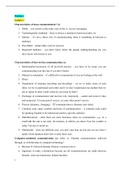Resume
Summary Topic: All things media? Emerging communication technologies and their impact on us and society (Readings & Lectures)
- Cours
- Établissement
Providing an in-depth and complete section of notes from the course of Topic: All things media? Emerging communication technologies and their impact on us and society. The present document includes a summary of all lectures and readings for this course. Notes include: - Notes from Lecture 1,2,...
[Montrer plus]




